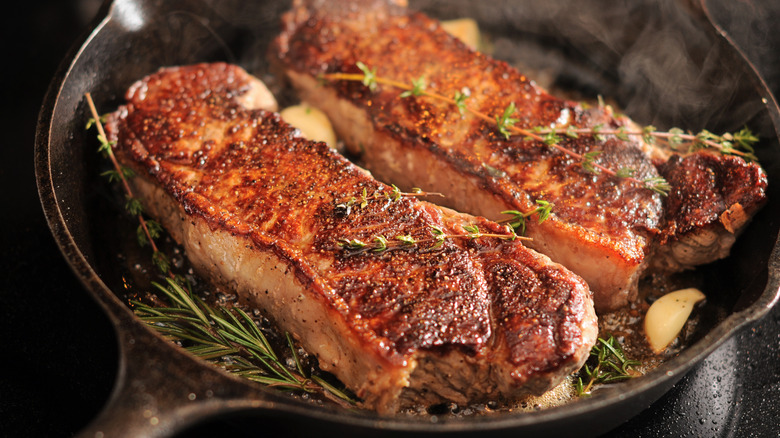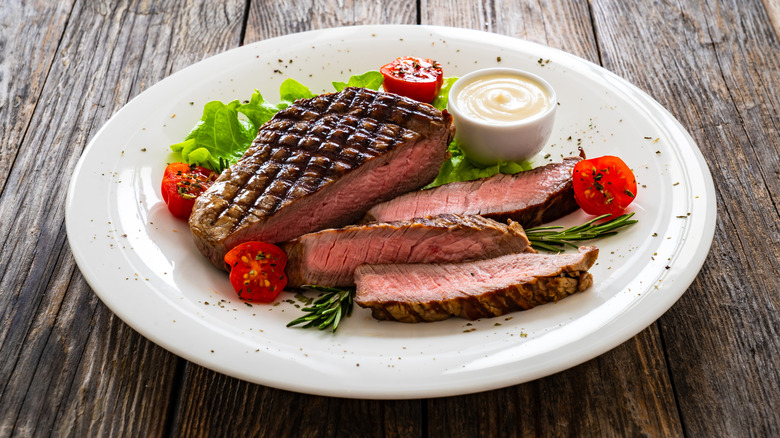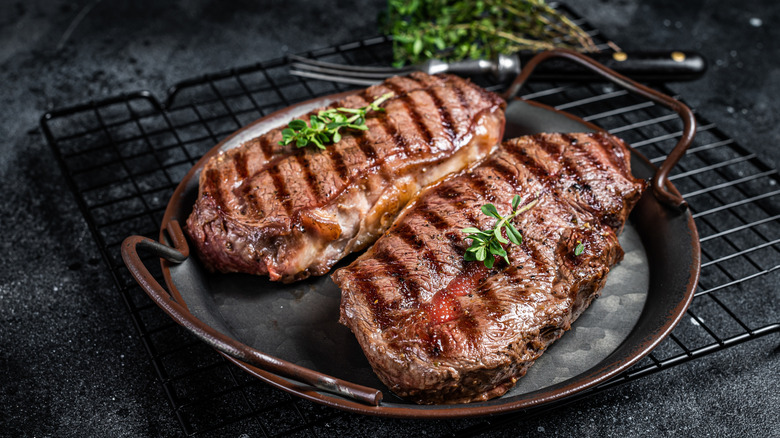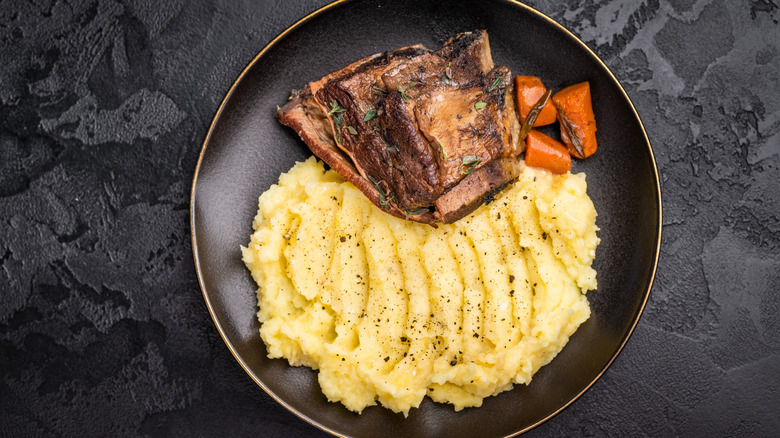
Jackf/Getty Images
There's nothing like sitting down to a fancy steakhouse dinner. With premium steak cuts, delicious sides and sauces, and other accoutrements like cocktails, wine, and desserts, steakhouse dining is in a class of its own. But just because steakhouses have an elite offering of special cuts, it doesn't mean you can't recreate your favorite dish in the comfort of your own home. But knowing which steaks to buy at the grocery store or butcher will make or break your final dish. Choosing the wrong cut can leave you disappointed and still longing for a meal at the restaurant instead.
To avoid that disappointment, we looked to the experts. We spoke with two seasoned steakhouse chefs — Guillaume Thivet, Executive Chef at Grand Brasserie in New York and Christopher Von Egger, Regional Chef at Halls Chophouse Nashville — to get their insights on which store-bought steaks are the best. Read on to discover their favorites to add to your next shopping list.
Ribeye

Alizah Smith/Shutterstock
Ribeye is known for its unrivaled marbling, rich flavor, and tender texture. Sourced from an area of the cow along the ribs, the ribeye is fattier than other prized steaks like the strip steak. This gives it a juicier, more buttery finish. Like many steak cuts, ribeye is available both boneless and bone-in. Many stores — including bulk-wholesaler Costco — offer beautiful ribeye cuts, making it a convenient and easy option for those looking for store-bought steaks.
"Ribeye is a very forgiving cut perfect for those still perfecting their steak cooking methods. Because they're already soft, high-heat, quick cooking methods like grilling or pan-searing bring out their flavor without drying them out," says Guillaume Thivet. "The quick sear also creates a rich, caramelized crust while keeping the inside juicy," he adds. If you opt for a bone-in variety, be sure to check that the steak is cooked through before removing it from the grill or pan; the inclusion of the bone can sometimes cause the steak to cook unevenly, with the area around it cooking more slowly.
New York strip steak

Jjpoole/Getty Images
New York strip steak is cut from the short loin, one of the most tender areas of the cow. Because this area isn't filled with tough muscle, it's home to many sought-after steak cuts in addition to the strip steak, like the tenderloin and filet mignon.
The New York strip steak is beloved for its intense beef flavor and well-marbled meat. It strikes the perfect balance between flavor and tenderness, so it's a happy medium for those who can't decide between the two. It can also be bought boneless or bone-in (depending on preference) and can be cooked many different ways, from grilled to pan-roasted.
Because it's so versatile, the New York strip is the ideal option to buy from your grocery store or butcher. It's a great candidate for grilling — just be sure to prepare the steaks properly — and it will be ready to eat after just a few minutes over the flames. This steak can also be pan-seared, reverse-seared, sous vide, or any combo of these approaches. Just be sure to double-check the internal temperature before serving to confirm the level of doneness; steaks at 110 degrees Fahrenheit are rare, while those at 140 degrees and above will be medium-well.
Filet mignon

Andrei Iakhniuk/Getty Images
Filet mignon is considered by many to be the crème de la crème of steaks. Cut from the narrow end of the tenderloin, it is unbelievably tender and has a milder beef flavor than many other cuts of steak. It is considered elegant, refined, and is coveted for its melt-in-your-mouth texture. This high-end steak, however, also comes with a higher price tag than other cuts. When shopping in most grocery stores or butchers, it will cost you a premium, which is why it's often reserved for special occasions like birthdays, holidays, or anniversaries.
No matter why you choose this elite steak, it can be prepared in several different ways. Consider grilling or reverse-searing, but either way, there's an important step you shouldn't skip before cooking for the best results. "One of the main mistakes I see home chefs make is not temping the meat before cooking it," says Christopher Von Egger. "To do this, let the meat sit out for 20-30 minutes before cooking to help relax it and reduce cooking times."
Sirloin

Gbh007/Getty Images
Unlike more premium cuts, sirloin is an affordable option for those looking for nice steaks at the grocery store. The versatile steak can be cooked as-is or marinated; its rich flavor pairs well with umami marinade ingredients like balsamic vinegar, Worcestershire sauce, or soy sauce. Sirloin is also easy to cook using several different methods (pan searing, grilling, sous vide, etc.), making it perfect for beginners.
Sourced from the rear back of the cow, sirloin is lean and has a firmer texture — so it's great for those watching their diets — but that doesn't mean it doesn't have a lot of flavor. It's beefier than more marbled cuts and pairs well with a wide range of side dishes and sauces. "Some of my favorite sides with steak are mashed potatoes, grilled green beans, asparagus, broccoli, mac & cheese, and chilled soups," says Christopher Von Egger. "As far as sauces go, Worcestershire sauce, chimichurri, and red wine au jus are my go-tos."
Tenderloin

Nightanddayimages/Getty Images
Beef tenderloin is, as the name implies, one of the most tender cuts of steak. It comes from an area along the rear spine where there's very little muscle, and as a result, the steak is tender and juicy. However, it requires the right cooking method to prevent it from drying out. Because the tenderloin is less marbled than other steaks like ribeye, it can get tough if it's overcooked. Consider slow-cooking it in the oven to lock in moisture, and don't cook the meat past medium rare to maintain its tenderness.
This sought-after steak is available at most grocery stores, meat counters, and butchers, so it's easy to get your hands on. But it's a commitment — the whole tenderloin is enough meat to feed a large group. Most tenderloins are between 4 and 6 pounds, and 1 pound can usually feed about two people. Luckily, it can be broken down into smaller pieces and frozen, so you can save extras for later.
Flat iron steak

Mironov Vladimir/Shutterstock
Though flat iron steak may be a less well-known store-bought steak, that doesn't make it any less delicious. This cut is beautifully marbled and has a strong beef flavor, making it ideal for those who like a buttery, rich taste. Unlike other premium cuts, the flat iron comes from a highly muscled area (the shoulder of the cow) — but fortunately, it remains tender thanks to the removal of excess connective tissue.
Flat iron steaks can be grilled, reverse-seared, or pan-seared to bring out the flavor; grilling offers an added hint of smoke, while pan-searing gives you a tasty exterior crust. And unlike many other steaks recommended by our steakhouse chefs, this cut is surprisingly affordable. The budget-friendly option is ideal for those who aren't quite confident in their cooking abilities; even if it doesn't turn out perfectly, you aren't wasting a lot of money like you would be with a filet mignon or ribeye.
Short ribs

Mironov Vladimir/Shutterstock
In the chuck area of the steak, five ribs are too short to be used as steaks, hence they're known as the short ribs. While these ribs may have a bad reputation for being less tender than more sought-after cuts, they can be delicious when cooked slowly over low heat for an extended period. They have rich marbling and a strong beefy flavor, making them perfect for braising with ingredients like red wine, beef stock, or stout.
Guillaume Thivet recommends patting the short ribs dry before seasoning with salt and pepper and browning all the sides to add extra flavor. Then, remove them from the pan and sauté veggies like onions, carrots, and celery before adding tomato paste, garlic, and herbs. Add wine and stock, scrape up the browned bits from the pan, and cover. Cook low and slow until the short ribs are fall-off-the-bone tender and infused with amazing flavor. Serve them over creamy mashed potatoes for the ultimate indulgent dinner, no reservation required.



